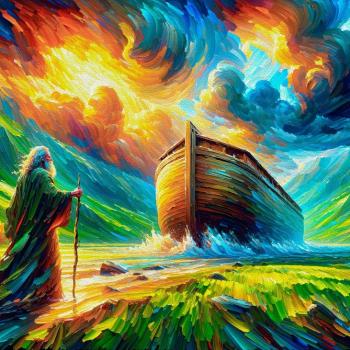The blessing of water reflects all of salvation history in terms of water, from the Spirit brooding over the waters at the beginning of creation to Christ's baptism in the Jordan, a baptism which is consummated on the cross where "your Son willed that water and blood should flow from his side as he hung upon the cross" (RCIA 215; R 97). The renunciation of evil and profession of faith provide another rite of passage in which the candidate turns from evil to God. Only a few words are said. But these words are extremely important because such a rite acknowledges our ability to make promises to God and to carry them out. In a world in which forgotten promises are legion, we affirm here that words do have meaning for us. Furthermore, the renunciation of evil and profession of faith reveal the need for the personal commitment demanded by baptism. Baptism is the sacrament of faith, of full, personal commitment to Christ. In this sense, baptism is the sacrament of Christian maturity.
The water bath, the center and heart of the initiatory ritual, is an extremely simple action in which the Trinity is invoked and water is employed. As a consequence of this simplicity of ritual and profundity of meaning both preliminary and subsequent rites unfold the meaning of baptism. For example, the anointing of the head after baptism expresses the neophyte's membership in the priestly people:
As Christ was anointed Priest, Prophet, and King, so may you live always as a member of his body, sharing everlasting life. (RCIA 224; R 101).
The clothing with the festal garment, an extension of the ancient anointing of the whole body, speaks of our putting on Christ; the candle flame reminds us that baptism is an enlightenment and that all Christians should "walk always as children of the light and keep the flame of faith alive in . . . [their] hearts" (RCIA 226; R 102).
Confirmation supplements the Christic dimensions of baptismal initiation with a necessary pneumatic emphasis. As indicated above, this in no way implies that the Spirit is operative only at this point in time. A perusal of the baptismal prayers is sufficient to dispel such notions. However, this view has been proposed by eminent liturgists, especially those in the Anglican communion, such as Gregory Dix. But not only is the Spirit invoked over the water so that through immersion in the consecrated waters the Spirit may effect the candidate's burial "with Christ in the death of baptism" (RCIA 215; R 97), but all the rites that follow baptism in water commemorate the fact that the candidates have been "given . . . a new birth by water and the Holy Spirit" (RCIA 225; R 1 O1).
Confirmation focuses more directly on the Spirit, particularly upon the Spirit as prophetic force. The celebrant prays over the candidates and imposes his hand upon them. Remembering their redemption in Christ through water and Spirit -- "you freed your sons and daughters from sin and gave them new life by water and the Holy Spirit" (RCIA 230; R 104) -- the presider asks God to send the prophetic Spirit upon the neophytes, to empower them, as the rest of the community has been empowered, to preach to others what they have received. Confirmation brings out the fact that those who have been given the gift of life in Christ must hand it on to others. The parable of the buried talents is instructive here. Baptism is a gift, not to be hoarded but to be cultivated. Confirmation completes baptism by invoking God to enable Christians to live out their baptism throughout their lives. In particular, confirmation reminds us that baptism is a gift to be both cherished and given to others.
The concluding sacrament of initiation, the final rite of the Easter vigil, is the Eucharist. The candidates' journey is finished. They join the redeemed community around the eucharistic table, standing as equals in the sight of the Lord. The neophytes can now bring their own gifts to the altar, make the eucharistic prayer their own by their shouted acclamation "Amen," and receive the food from heaven along with their new sisters and brothers. Thus, they reach their goal in the eucharistic sacrament: the celebration of the union of each baptized member of the body in Christ, the head. Centuries ago, Alcuin echoed this sentiment when he spoke of the Eucharist "confirming" baptism: "Thus it [baptism] is confirmed [that is, completed] by the Lord's body and blood, in order that he [the neophyte] might be a member of the head who for him suffered death and rose again."
In the Eucharist the community continues to "remember" its baptism into the Lord who died and was raised that all might be saved. Commemorating the mighty acts of God among his people, particularly the paschal mystery of Jesus, they petition God that they may continue to live in the power of these signs of God's love. With assurance that they can, they offer themselves, through and with Christ and in the power of the Spirit, to the Father who calls the community to fullness of life and love.




